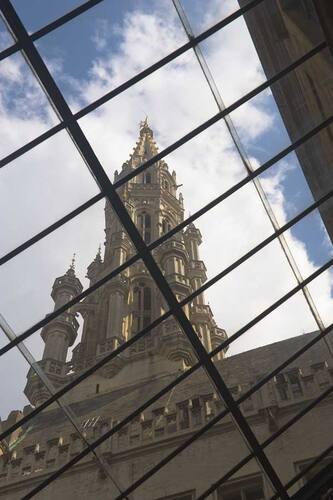Around a cobbled right-angled market square, La Grand-Place in Brussels, the earliest written reference to which dates back to the twelfth century, features buildings emblematic of municipal and nobleman powers, and the old homes of firms. An subject area jewel, it stands as associate exceptional and extremely victorious example of an eclectic mixing of subject area and inventive designs of culture, which illustrates the vitality of this vital political and industrial centre.
The Grand-Place testifies in certain to the achievement of capital of Belgium, mercantile city of northern Europe that, at the peak of its success, rose from the terrible bombardment inflicted by the troops of Louis XIV in 1695. Destroyed in three days, the centre of the medieval city beneathwent a reconstruction campaign conducted under the direction of town jurist, which was spectacular not solely by the speed of its implementation, but conjointly by its decorative wealth and subject area coherence. Today the Grand-Place remains the devoted reflection of the sq. destroyed by the French artillery and testifies to the figurative plan of the power and pride of the capital of Belgium bourgeois United Nations agency selected to revive their town to its former glory instead of make in an exceedingly up to date vogue, a trend commonly determined elsewhere.
 A pinnacle of Brabant Gothic, the Hôtel de Ville (City Hall), accentuated by its bell tower, is the maximum reputable landmark of the Grand-Place. Built in the first fifteenth century, the building partially at liberty bombardments and underwent many transformations over time. Its ornamental programme is for the most part attributable to the restoration campaigns conducted within the late nineteenth century. Facing it, the King's House, repaired in the historicist vein, is completely integrated into the ensemble. Its elevation is in keeping with the Gothic style structure before the bombardment and testifies remarkably to the ideals of the discourse conservation of monuments advocated within the nineteenth century. The King's House has been occupied for decades by town Museum. On both sides of those monuments symbolic of public authority were homes occupied by powerful firms. Each totally different however engineered over a terribly short time, they illustrate remarkably the Baroque architecture of the late seventeenth century, with a singular construction of decorations and the gables, sometimes fretted, sometimes a lot of classical. Each house takes a name and unique attributes, heightened with gold, reminiscent of the standing of its occupants. It is interesting to notice that this can be a rare example of a sq. while not a church or the other place of worship, which emphasizes its mercantile and body nature.
A pinnacle of Brabant Gothic, the Hôtel de Ville (City Hall), accentuated by its bell tower, is the maximum reputable landmark of the Grand-Place. Built in the first fifteenth century, the building partially at liberty bombardments and underwent many transformations over time. Its ornamental programme is for the most part attributable to the restoration campaigns conducted within the late nineteenth century. Facing it, the King's House, repaired in the historicist vein, is completely integrated into the ensemble. Its elevation is in keeping with the Gothic style structure before the bombardment and testifies remarkably to the ideals of the discourse conservation of monuments advocated within the nineteenth century. The King's House has been occupied for decades by town Museum. On both sides of those monuments symbolic of public authority were homes occupied by powerful firms. Each totally different however engineered over a terribly short time, they illustrate remarkably the Baroque architecture of the late seventeenth century, with a singular construction of decorations and the gables, sometimes fretted, sometimes a lot of classical. Each house takes a name and unique attributes, heightened with gold, reminiscent of the standing of its occupants. It is interesting to notice that this can be a rare example of a sq. while not a church or the other place of worship, which emphasizes its mercantile and body nature.
No comments:
Post a Comment